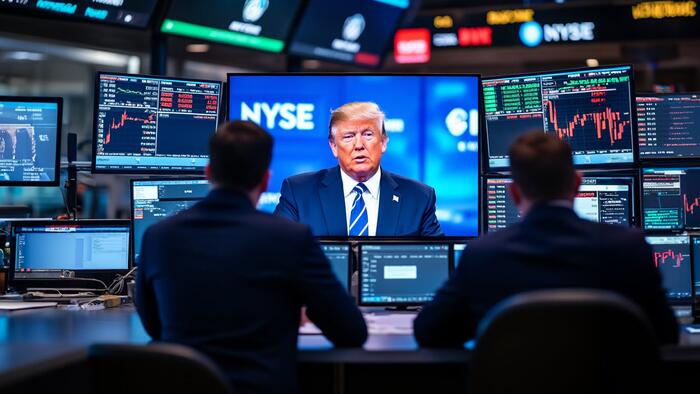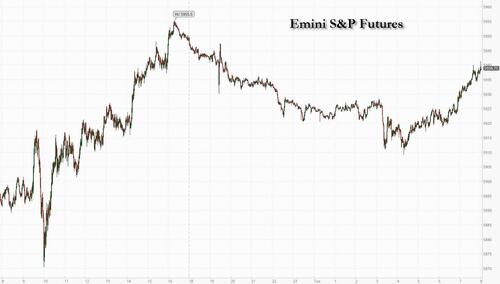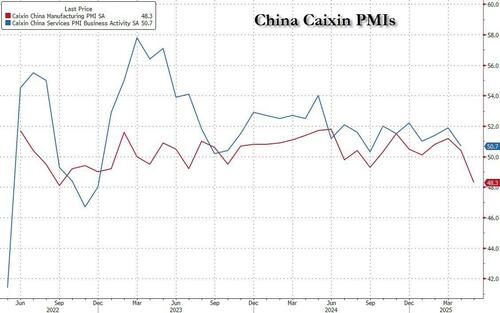


US equity futures follow European markets lower, although off session lows, amid more tariff gloom confronting traders this morning: the pressure of Trump’s tariffs pushed China’s manufacturing PMI survey to its lowest since 2022, while the OECD cut its 2025growth outlook for a second time. As of 8:00am, S&P futures are down 0.2%, erasing almost a 0.7% drop as the US benchmark is set to continue a run of daily swings between gains and losses; Nasdaq 100 futures were flat even as all Mag 7 are modestly lower premarket (AMZN/META -0.4%). Meanwhile, the OECD slashed its global economic forecast again, blaming trade anxiety for holding back investment and warning that protectionism is inflationary (which it clearly isn't judging by recent inflation prints). The OECD now expects 2025 and 2026 US GDP to print 1.6% and 1.5%, respectively; this is below the G20 average of 2.9% and 2.9% in 2025 and 2026, respectively. Bond yields are 2-3bp lower; the dollar climbed on Tuesday, posting a broad-based rebound after closing Monday at the lowest point since July 2023; all G-10 currencies declined, with the Australian dollar and Swedish krona under-performing peers. Commodities are mixed with oil moving higher and precious metals lower. Overnight headlines are mostly muted. Today's US economic data includes April factory orders and JOLTS job openings (10am).
In premarket trading, Mag 7 stocks were mixed (Nvidia +0.4%, Tesla +0.3%, Meta +0.1%, Apple -0.2%, Microsoft -0.2%, Amazon -0.2%, Alphabet -0.3%). Nuclear stocks (CEG) gained in US premarket trading after Constellation Energy agreed to sell power from an operating nuclear plant in Illinois to Meta Platforms, an agreement that could lead to the construction of a new reactor at the site. Here are some of the biggest US movers today:
Earlier today, the Paris-based OECD slashed its global growth forecasts for the second time this year, saying that a combination of trade barriers and uncertainty are hitting confidence. The alert comes two months into President Donald Trump’s push to reshape global trade and agree new deals, with few signs of a breakthrough in talks with major partners.
“We’re clearly seeing a lot of volatility and investors want more visibility,” Massimiliano Bondurri, founder and chief executive officer of SGMC Capital in Singapore, said on Bloomberg TV. “It’s normal that markets are actually going to be flip-flopping.”
The US economy has also increasingly shown signs of a moderate yet broad-based softening. A report due later Tuesday on April vacancies is forecast to show a decline in job openings to the fewest since 2020 as companies are growing more conscious about consumers’ cost-saving efforts. Payrolls data scheduled for Friday will probably show a slowing in the pace of hiring.
“Markets are trading higher than on April 2, but earnings have been revised down, global growth too,” said Gilles Guibout, head of European equities at AXA Investment Managers in Paris. “Are we really in a better position? The answer is ‘no’.”
Meanwhile, Bloomberg reported that Trump was working the phones Monday and took to social media to try to sway Republican holdouts on his multi-trillion dollar tax bill. Investors and traders have raised concern that the legislation could worsen a ballooning budget deficit and US debt pile.
Conference season kicks off in earnest this week, with CEOs gathering for gabfests from San Francisco to New York at a time when their confidence in the economy has barely recovered from the shocks of “Liberation Day.”
In Europe, the Stoxx 600 pared losses of as much as 0.5%, while the euro fell 0.4% against the dollar after inflation in the euro-area eased more than expected, dipping below the European Central Bank’s 2% target and supporting the case for interest rates to be lowered further. Here are the most notable European movers:
Earlier in the session, Asian stocks edged higher as investors looked ahead to a potential conversation between US President Donald Trump and China’s Xi Jinping to dial down the recent flare-up in trade tensions. The MSCI Asia Pacific Index rose as much as 0.5%, before paring much of the gain. Concerns over persistent weakness in China’s economy also kept a lid on sentiment, after the latest Caixin PMI factory data showed the worst slump in over two years amid higher US tariffs.
Key benchmarks in Hong Kong jumped more than 1%, with notable advances also in Taiwan and mainland China. South Korean markets were closed for a presidential election Tuesday after months of political chaos. The White House said Trump and Xi are “likely” to speak this week, fueling optimism that trade negotiations between the two nations can get back on track. China hasn’t confirmed any decision on such talks, however, and investors remain wary after Washington and Beijing recently accused each other of violating an agreement reached in May.
In FX, the dollar rose against all of its Group-of-10 peers, erasing part of Monday’s drop, while US Treasuries gained. Focus is on job openings data, which will give an insight into the health of the labor market ahead of non-farm payrolls on Friday. Bloomberg Dollar Spot Index inched up 0.2% on Tuesday, having dropped on Monday due to a flare-up in global trade tensions. The gauge saw its weakest level since 2023 after data showed that US factory activity contracted in May for a third month running. USD/JPY gains 0.2% to ~143. The euro fell 0.4% against the dollar to 1.1383 after inflation in the euro-area eased more than expected, dipping below the European Central Bank’s 2% target and supporting the case for interest rates to be lowered further.
In rates, US Treasuries gained, sending yields about 2bps lower across the curve, as US stock futures fell; 10-year yield -2bps to 4.42%. Gilts outperformed after the Bank of England’s Catherine Mann said late Monday there’s a tension between cuts to interest rates and efforts to unwind quantitative easing; 30-year yield falls 7bps to 5.34%
Today's US economic data includes April factory orders and JOLTS job openings (10am). Fed speaker slate includes Goolsbee (12:45pm), Cook (1pm) and Logan (3:30pm).
Market Snapshot
Top Overnight News
A more detailed look at global markets courtesy of Newsquawk
APAC stocks traded mostly higher as the region took impetus from the rebound on Wall St but with gains capped following disappointing Chinese Caixin Manufacturing data and as trade uncertainty lingered. ASX 200 edged higher amid strength in mining stocks but with further upside limited as defensives lagged and after mixed data releases including a surprise contraction in net exports contribution to GDP. Nikkei 225 kept afloat but lacked firm conviction after recent currency fluctuations and after a deluge of comments from BoJ Governor Ueda who reiterated they will continue to raise interest rates if the economy and prices move in line with forecasts, but also noted there was no preset plan for rate hikes and that they will raise interest rates only if the economy and prices turn up again and outlooks are likely to be realised. Hang Seng and Shanghai Comp were underpinned after the US reportedly extended the tariff pause on some Chinese goods to August 31st, while the White House Press Secretary stated that US President Trump and Chinese President Xi will likely talk this week, although the upside was restricted in the mainland given the lack of confirmation by Beijing regarding Trump-Xi talks and as participants also digested disappointing Caixin Manufacturing PMI data which showed its first contraction in eight months and printed its weakest since September 2022.
Top Asian News
European bourses (STOXX 600 -0.3%) opened modestly firmer across the board, but sentiment soon slipped surrounding reports that Dutch Far Right Leader Wilders, confirmed to quit government coalition. European sectors opened with a strong positive bias, but sentiment soon dwindled to display a negative picture in Europe. Telecoms took the top spot, then joined by Utilities; Financial Services was the morning’s outperformer, lifted by upside in UBS (+2.7%) after it received a broker upgrade at Jefferies. Basic Resources have been pressured today given the downside in metals prices following weaker-than-expected Chinese Caixin Manufacturing PMI. US equity futures are broadly in negative territory, in-fitting with the risk tone and scaling back from some of the upside seen in the prior session.
Top European News
BoE TSC
FX
Fixed Income
Commodities
Geopolitics: Middle East
Geopolitics: Ukraine
US Event Calendar
Central Banks
DB's Jim Reid concludes the overnight wrap
This morning DB host our 29th annual European LevFin Conference, the largest in the continent with well over 1000 issuers and investors attending. I've been speaking at it for 20 years now and kick off the event at 8am this morning. In previous years the likes of Bon Jovi, Duran Duran and The Killers, amongst others, have performed. Hopefully they've taken away some sage advice on their CLO portfolios. These events have evolved over the years across the industry and there is now sadly more chance of having my band perform than rubbing shoulders with Jon Bon Jovi.
Looking on the Mr Brightside, yesterday we released our latest World Outlook from DB Research, which updates all our global macro forecasts. It is called “The Limitations of Liberation…” You can read the full report here. It’s a difficult time to forecast right now given the relentless crossfire of trade headlines. But there’s a growing sense that we’re now on a turbulent but sustained path towards de-escalation. Even if the US administration remain hawkish on trade, we have already seen there are limits to that approach, particularly in the face of market turmoil and declining approval ratings for President Trump. So although we think there’s likely to be prolonged uncertainty and a notable slowdown in US growth over H2, the de-escalation so far will support growth relative to earlier expectations.
Nevertheless, a lot of collateral damage has already been done. Our outlook argues that the structural foundations of US exceptionalism – particularly the ability to finance itself cheaply via the dollar’s reserve status – have begun to erode. So we remain structurally bearish on the dollar and expect US term premia to keep rising.
The biggest risk to our view would be if the US administration reverts to a more aggressive stance after the court ruling. But in a world where funding US deficits is now going to be structurally harder, Washington may not have the latitude it once did. For Europe, this may be a rare window to recapture the geopolitical and economic momentum. Indeed, their economy has shown surprising resilience so far, and we revised up our 2025 Euro Area forecast back to 0.8%, where it was in our last World Outlook in November. Indeed since last November the largest growth downgrade is the US and the largest up move is Germany. See the full report for much more.
When it comes to the last 24 hours, June has got off to a mixed start amidst the latest trade tensions and an underwhelming ISM manufacturing print. To be fair markets have been more resilient than sentiment with the S&P 500 managing to recover from a weak open to close +0.41% higher, even if futures have given up these gains this morning. Bonds saw a renewed sell off, with the 30yr Treasury yield (+3.4bps) moving up to 4.97% before rallying back a basis point this morning. Matters also weren’t helped by a fresh rise in oil prices, as OPEC+ only increased supply in line with expectations for July over the weekend. Brent crude was up +2.95% to $64.63/bbl, which in turn led to a renewed bout of concern about inflationary pressures. So although there wasn’t a single story driving markets, the incremental newsflow predominantly leaned in a more negative direction.
To be fair, there wasn’t much optimism going into the session, as markets were already reacting to Trump’s tariff announcement after the close on Friday, where he promised to double the steel and aluminium tariff rate to 50%. As a reminder, that’s one where Trump’s still able to take action, as the court ruling last week did not include the steel/aluminium/automobile tariffs. And from a market perspective, it reminded investors that the administration wasn’t backing down from an aggressive trade posture, despite the various court rulings.
Then as the US session got underway, the latest ISM manufacturing print for May came through. That unexpectedly fell to a 6-month low of 48.5 (vs. 49.5 expected), so that added to investor nerves about the near-term outlook. Strikingly, the import component slumped to just 39.9, which is beneath its low point during the Covid pandemic, and at a level unseen since May 2009 as the economy was emerging from the GFC. Meanwhile, the prices component remained elevated at 69.4, so there wasn’t much to get excited about, and it offered a fresh indication of how the trade war was having a tangible economic impact.
That backdrop was a pretty tough one for markets, and the various developments meant the dollar index (-0.63%) continued to slide, moving very close to its post-Liberation Day low back in late-April. In bond markets, there was another round of déjà vu as the 30yr Treasury yield bounced off the 5% mark again. That’s proved something of a resistance level in this cycle, and by the end of the session, it was up +3.5bps to 4.97% (4.96% in Asia). That move in yields was echoed across the curve, with the 10yr yield (+3.9bps) up to 4.44%, whilst the 2yr yield (+3.7bps) was up to 3.94%. Meanwhile in Europe, yields on 10yr bunds (+2.4bps), OATs (+2.8bps) and BTPs (+1.9bps) all moved higher as well. And the Italian-German 10yr spread fell to its tightest level since September 2021, at just 97.5bps.
Equities also struggled for much of the day, with the S&P 500 trading as much as -0.85% lower shortly after the ISM release. However, the equity mood improved as the session went on, with the S&P closing +0.41% higher led by gains for energy (+1.15%) and information technology (+0.89%) sectors. The Mag-7 advanced +0.59%, while the Philadelphia Semiconductor index (+1.57%) saw an outsized gain. Still, the overall equity mood was far from upbeat, with just over half of the S&P 500 stocks moving lower on the day. In Europe, markets closed before the late US rally, with the STOXX 600 (-0.14%) falling back slightly. Meanwhile, gold prices (+2.81%) were one of the few beneficiaries of the more anxious mood, posting their biggest daily jump in almost a month.
Asian equity markets are mostly higher this morning with the Hang Seng (+1.47%) recovering from yesterday's losses. The S&P ASX 200 (+0.41%) briefly reached a near four-month high following the release of the RBA’s May meeting minutes, which largely indicated a dovish outlook from the central bank. Elsewhere, mainland Chinese markets have resumed trading after a long weekend, with the CSI (+0.49%) and the Shanghai Composite (+0.48%) both higher perhaps after US Press Secretary Leavitt last night suggested that Trump and Xi could still speak as soon as this week. S&P 500 (-0.42%) and NASDAQ 100 (-0.40%) futures are both lower though.
Early morning data revealed that China’s manufacturing activity in May contracted at its most rapid rate since September 2022, as the Caixin/S&P Global manufacturing PMI printed at 48.3 (compared to the expected +50.7) and fell sharply from 50.4 in April. This decline was exacerbated by a significant drop in new export orders, underscoring the effects of stringent US tariffs.
In FX, the Japanese yen (-0.32%) weakened past 143 against the dollar, ending a three-day winning streak, despite BOJ Governor Kazuo Ueda expressing willingness to raise interest rates once the central bank is sufficiently convinced that economic and price growth will resume after a period of stagnation.
In terms of other data releases yesterday, UK mortgage approvals were weaker than expected in April, coming down to a 14-month low of 60.5k (vs. 62.8k expected). We also got the final manufacturing PMIs for May. The Euro Area PMI was unchanged from the flash print at 49.4, but the US number was revised down three-tenths from the flash reading to 52.0.
To the day ahead now, and data releases include the Euro Area flash CPI print for May, along with the unemployment rate for April. We’ll also get the US JOLTS report for April, and factory orders for April. Central bank speakers include BoJ Governor Ueda, the Fed’s Goolsbee, Cook and Logan, BoE Governor Bailey, Deputy Governor Breeden, and the BoE’s Mann and Dhingra.



